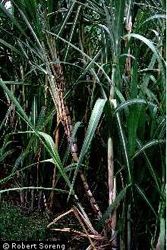Element:ScBIMV
DescriptionSugarcane bacilliform virus (SCBV) is a pathogen of sugarcane (Saccharum Spp. and Saccharum L. interspecific hybrids) which was first observed in Cuba in 1985 (Rodriguez-Lema et al. 1985) and first purified from a sugarcane variety growing in Morocco (Lockhart and Autrey 1988). It is a plant pararetrovirus of Badnavirus genus, Caulimoviridae family (International Committee on the Taxonomy of Viruses -ICTV- Fauquet et al. 2005). To date have been completely sequenced two isolate, one from Morocco (ScBMorV, Bouhida et al. 1993) and one from Australia (ScBIMV, Geijskes et al. 2002). The SCBV sequence selected for our study is that isolated from the Australian "Ireng Maleng” variety (ScBIMV) and according to Llorens et al. 2009it is located within Class 2 of the Caulimoviridae family. ScBIMV has non-enveloped bacilliform-shaped particles with a size of approximately 30 nm x 130 nm, although virions up to 500 nm in length have been reported (Lockhart and Autrey 1988; Geijskes et al. 2004), containing a circular dsDNA of about 7.6 Kb in size (7687 bp long) (Geijskes et al. 2002). Analysis of the genome sequence reveals that the plus strand contains three Open reading frames (ORFs I, II, III) which size, number and arrangement are similar to those of the badnaviruses (Geijskes et al. 2002). The predicted ORF I product of 21.8 kDa shows sequence similarity to the Caulimoviridae virion associated proteins (VAPs) encoded by the corresponding ORFs I. The function of ORFII product (16.4 kDa) has not yet been demonstrated, even if a DNA-binding property has been hypothesized for the ORF II products of some badnaviruses (Borah et al. 2009; Jacquot et al. 1996). The polyprotein encoded by ORF III contains the typical Badnavirus cell-to-cell movement protein (MOV), viral coat protein (COAT), aspartic protease (PR), reverse transcriptase (RT) and RNase H (RH) domains (Geijskes et al. 2002). At the C-terminus of the COAT (gag)-like domain is present the large cysteine-rich region characteristic of Badna- and Tungroviruses (Llorens et al. 2009; Hull 1996; Bouhida et al. 1993). SCBV is present in the majority sugarcane-growing countries (Autrey et al. 1995; Comstock and Lockhart 1990) causing yield reductions in some varieties. The symptoms of infection are variable (Geijskes et al. 2002) and severely infected varieties display chlorotic leaf speckle, stunted growth, reduction in internodal elongation and premature death, while other varieties remain symptomless (Viswanathan et al. 1996; Comstock and Lockhart 1990; Lockhart and Autrey 1988). The virus is transmitted by natural vectors -as the pink (Saccharicoccus sacchari) and grey (Dysmicoccus boninsis) sugarcane mealybugs- as well as mechanically to sugarcane plants and by Agroinoculation to both rice and banana plants (Lockhart and Autrey 1988, 1991; Autrey et al. 1995; Bouhida et al. 1993). Geijskes et al. (2004) investigated the possible integration of SCBV sequences into the sugarcane genome. Their results provided evidence indicating that SCBV did not integrate into the genomes of the sugarcane cultivars tested and that the high molecular weight DNA observed were SCBV concatamers comprising up to four genome copies (derived by an open circular concatamer formation). However, considering that SCBV is hypervariable, the authors do not discard the possibility that a distant strain of SCBV is not integrated into the sugarcane genomes tested or into other sugarcane genomes. Structure
Related literature |
|
|||||||||||||||||||||||||||||||||||||||||


